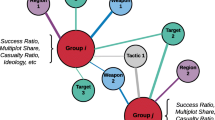Abstract
This paper uses an extensive network approach to “East Turkistan” activities by building both the one-mode and the bipartite networks for these activities. In the one-mode network, centrality analysis and spectrum analysis are used to describe the importance of each vertex. On this basis, two types of core vertices — The center of communities and the intermediary vertices among communities — are distinguished. The weighted extreme optimization (WEO) algorithm is also applied to detect communities in the one-mode network. In the “terrorist-terrorist organization” bipartite network, the authors adopt centrality analysis as well as clustering analysis based on the original bipartite network in order to calculate the importance of each vertex, and apply the edge clustering coefficient algorithm to detect the communities. The comparative and empirical analysis indicates that this research has been proved to be an effective way to identify the core members, key organizations, and communities in the network of “East Turkistan” terrorist activity. The results can provide a scientific basis for the analysis of “East Turkistan” terrorist activity, and thus provide decision support for the real work of “anti-terrorism”.
Similar content being viewed by others
References
Watts D J and Strogatz S H, Collective dynamics of ‘small-world’ networks, Nature, 1998, 393(1): 440–442.
Barabási A L and Albert R, Emergence of scaling in random networks, Science, 1999, 286(5439): 509–512.
Couzin I D, Ioannou C C, Demirel G, et al., Uninformed individuals promote democratic consensus in animal groups, Science, 2011, 332(6062): 1578–1580.
Barabási A L, Gulbahce N, and Loscalzo J, Network medicine: A network-based approach to human disease, Nature Reviews Genetics, 2011, 12(1): 56–58.
Li Z P, Wang R S, Zhang X S, et al., Self-organizing map of complex networks for community detection, Journal of Systems Science and Complexity, 2010, 23(5): 931–941.
Zheng X L, Zhong Y G, Zeng D, and Wang F Y, Social influence and spread dynamics in social networks, Frontiers of Computer Science, 2012, 6(5): 611–620.
Zheng X L, Zeng D, Li H Q, et al., Analyzing open-source software systems as complex networks, Physica A: Statistical Mechanics and Its Applications, 2008, 387(24): 6190–6200.
Bohannon J, Counterterrorism’s new tool: ‘Metanetwork’ analysis, Science, 2009, 325(5939): 409–411.
Borgatti S P, Mehra A, Brass D J, et al., Network analysis in the social sciences, Science, 2009, 325(5916): 892–895.
Weinberger S, Social science: Web of war, Nature, 2011, 471: 566–568.
Krebs V E, Mapping networks of terrorist cells, Connections, 2002, 24(3): 43–52.
Carley K M, Lee J, and Krackhardt D, Destabilizing networks, Connections, 2002, 24(3): 79–92.
Chen H C, Chung W Y, Qin J L, et al., Uncovering the dark web: A case study of Jihad on the web, Journal of the American Society for Information Science and Technology, 2008, 59(8): 1347–1359.
Rodriguez J A, The March 11th terrorist network: In its weakness lies its strength, XXV. International Sunbelt Conference, Los Angeles, 2005.
Memon N, Harkiolakis N, and Hicks D L, Detecting high-value individuals in covert networks: 7/7 London bombing case study, IEEE/ACS International Conference on Computer Systems and Applications, Doha, March 2008.
Basu A, Social network analysis of terrorist organizations in India, Conference of the North American Association for Computational Social and Organizational Science, Notre Dame, Indiana, June, 2005.
Sageman M, Understanding Terror Networks, University of Pennsylvania Press, Philadelphia, 2004.
Liu J, Lectures on Whole Network Approach: A Practical Guide to UCINET, Shanghai Peoples Publishing House, Shanghai, 2009.
Borgatti S P, Carley K M, and Krackhardt D, On the robustness of centrality measures under conditions of imperfect data, Social Networks, 2006, 28(2): 124–136.
Newman M E J, Networks: An Introduction, Oxford University Press, Oxford, UK, 2009.
Palla G, Derenyi I, Farkas I, et al., Uncovering the overlapping community structure of complex networks in nature and society, Nature, 2005, 435(7043): 814–818.
Mucha P J, Richardson T, Macon K, et al., Community structure in time-dependent, multiscale, and multiplex networks, Science, 2010, 328(5980): 876–878.
Newman M E J, Communities, modules and large-scale structure in networks, Nature Physics, 2012, 8(1): 25–31.
Karrer B, Newman M E J, Stochastic block models and community structure in networks, Physical Review E, 2011, 83(1): 016107.
Wang F, Li T, Wang X, et al., Community discovery using nonnegative matrix factorization, Data Mining and Knowledge Discovery, 2011, 22(3): 493–521.
Wang Y, Di Z R, and Fan Y, Identifying and characterizing codes important to community structure using the spectrum of the graph, PLoS One, 2011, 6(11): e27418.
Fan Y, Li M H, Zhang P, et al., Accuracy and precision of methods for community identification in weighted networks, Physica A: Statistical Mechanics and Its Applications, 2007, 377(1): 363–372.
Newman M E J, Fast algorithm for detecting community structure in networks, Physical Review E, 2004, 69(6): 066133.
Zhang P, Wang J L, Li X J, et al., Clustering coefficient and community structure of bipartite networks, Physica A: Statistical Mechanics and Its Applications, 2008, 387(27): 6869–6875.
Author information
Authors and Affiliations
Corresponding author
Additional information
This work is supported by the Natural Science Foundation of China under Grants Nos. 70771011 and 61174150, the Program for New Century Excellent Talents in University of Ministry of Education of China under Grant No. NCET-09-0228, and Ph.D. Programs Foundation of Ministry of Education of China under Grant No. 20110003110027, and the China Scholarship Council (CSC).
This paper was recommended for publication by Editor DI Zengru.
Rights and permissions
About this article
Cite this article
Fu, J., Fan, Y., Wang, Y. et al. Network analysis of terrorist activities. J Syst Sci Complex 27, 1079–1094 (2014). https://doi.org/10.1007/s11424-014-3034-8
Received:
Revised:
Published:
Issue Date:
DOI: https://doi.org/10.1007/s11424-014-3034-8




